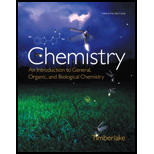
Concept explainers
Using the energy values for foods (see TABLE3.7), determine each of the following (round off the answer for each food type to the tens place):
a. the total kilojoules in two tablespoons of crunchy peanut butter that contains 6 g of carbohydrate, 16 g of fat, and 7 g of protein
b. the grams of protein in one cup of soup that has 110 kcal with 9 g of carbohydrate and 6 g of fat
c. the kilocalories in one can of cola if it has 40. g of carbohydrate and no fat or protein
d. the total kilocalories for a diet that consists of 68 g of carbohydrate, 9 g of fat, and 150 g of protein
TABLE 3.7 Typical Energy Values for the Three Food Types
| Food Type | kcal/g | kJ/g |
| Carbohydrate | 4 | 17 |
| Fat | 9 | 38 |
| Protein | 4 | 17 |
Want to see the full answer?
Check out a sample textbook solution
Chapter 3 Solutions
Chemistry: An Introduction to General, Organic, and Biological Chemistry (12th Edition) - Standalone book
- For dinner, Charles had one cup of clam chowder, which contains 21 g of carbohydrate, 12 g of fat, and 3 g of protein. Use the table given below for the typical energy values of given food types. Typical Energy Values for the Three Food Types Food Type kcal/g kJ/g Carbohydrate 4 17 Fat 9 38 Protein 4 17 Part A How much energy, in kilocalories, is in the clam chowder? (Round off the kilocalories to the tens place.) Express your answer to two significant figures and include the appropriate units. Part B How much energy, in kilojoules, is in the clam chowder? (Round off the kilojoules to the tens place.) Express your answer to two significant figures and include the appropriate units.arrow_forwardA Big Mac hamburger from McDonald’s contains 540 Calories. (a) How many kilojoules does a Big Mac contain?(b) For how many hours could the amount of energy in a Big Mac light a 100-watt light bulb? (1 watt = 1 J/s)arrow_forwardA) A hamburger comtains 409 kilocalories(409 cal). How many kJ is this? B) If a jogger burns 1225 kJ during her 5-mile run, How many kilocalories did she use up? How many hamburgers will it take to replace those kilojoules that she used up?arrow_forward
- An adult eats food whose nutritional energy totals approximately 2100 CalCal per day. The adult burns 1800 CalCal per day. How much excess nutritional energy, in kilojoules, does the adult consume per day? Express your answer using one significant figure.arrow_forwardI am having an issue with a problem and can't fidure it out. Using the table on the left, calculate the total kilocalories for carbohydrates (rounding off the kilocalories to the tens place). Express the energy to two significant figures and include the appropriate units. A 70.0-kgkg person had a quarter-pound cheeseburger, french fries, and a chocolate shake. Item Carbohydrate (g)(g) Fat (g)(g) Protein (g)(g) Cheeseburger 45 40. 47 French fries 47 18 4 Chocolate shake 76 10. 10.arrow_forwardThe label of a black cherry almond energy bar with a mass of 68 g lists the nutrition facts as 39 g of carbohydrate, 5 g of fat, and 10. g of protein.arrow_forward
- A reaction releases 421 kJ of energy. How many kilocalories does this correspond to?arrow_forwardA large mug containing 550 g of hot water at 87 ∘C is left sitting on a table, and gradually cools to 23 ∘C . How much heat was released to the environment (air, mug, and table) in kilocalories?arrow_forward(a) If you eat a hot dog, it will provide 160 Calories of energy. Express this energy in joules. (b) The packet of nonsugar sweetener in Figure 4.3 provides 16 kJ of nutritional energy. Express this energy in kilocalories.arrow_forward
- Methane, CH4, is a major component of marsh gas. When 0.5000 mol methane burns to produce carbon dioxide and liquid water, 445.1 kJ of heat is released. What is this heat in kilocalories?arrow_forwardIs the Sun exothermic or endothermic? Is it any less exothermic or endothermic in the winter, as opposed to the summer?arrow_forwardAn adult eats food whose nutritional energy totals approximately 2100 CalCal per day. The adult burns 1800 CalCal per day. How much excess nutritional energy, in kilojoules, does the adult consume per day?arrow_forward
 Chemistry: The Molecular ScienceChemistryISBN:9781285199047Author:John W. Moore, Conrad L. StanitskiPublisher:Cengage Learning
Chemistry: The Molecular ScienceChemistryISBN:9781285199047Author:John W. Moore, Conrad L. StanitskiPublisher:Cengage Learning General Chemistry - Standalone book (MindTap Cour...ChemistryISBN:9781305580343Author:Steven D. Gammon, Ebbing, Darrell Ebbing, Steven D., Darrell; Gammon, Darrell Ebbing; Steven D. Gammon, Darrell D.; Gammon, Ebbing; Steven D. Gammon; DarrellPublisher:Cengage Learning
General Chemistry - Standalone book (MindTap Cour...ChemistryISBN:9781305580343Author:Steven D. Gammon, Ebbing, Darrell Ebbing, Steven D., Darrell; Gammon, Darrell Ebbing; Steven D. Gammon, Darrell D.; Gammon, Ebbing; Steven D. Gammon; DarrellPublisher:Cengage Learning
- Chemistry: Matter and ChangeChemistryISBN:9780078746376Author:Dinah Zike, Laurel Dingrando, Nicholas Hainen, Cheryl WistromPublisher:Glencoe/McGraw-Hill School Pub Co
 Chemistry: Principles and PracticeChemistryISBN:9780534420123Author:Daniel L. Reger, Scott R. Goode, David W. Ball, Edward MercerPublisher:Cengage Learning
Chemistry: Principles and PracticeChemistryISBN:9780534420123Author:Daniel L. Reger, Scott R. Goode, David W. Ball, Edward MercerPublisher:Cengage Learning




